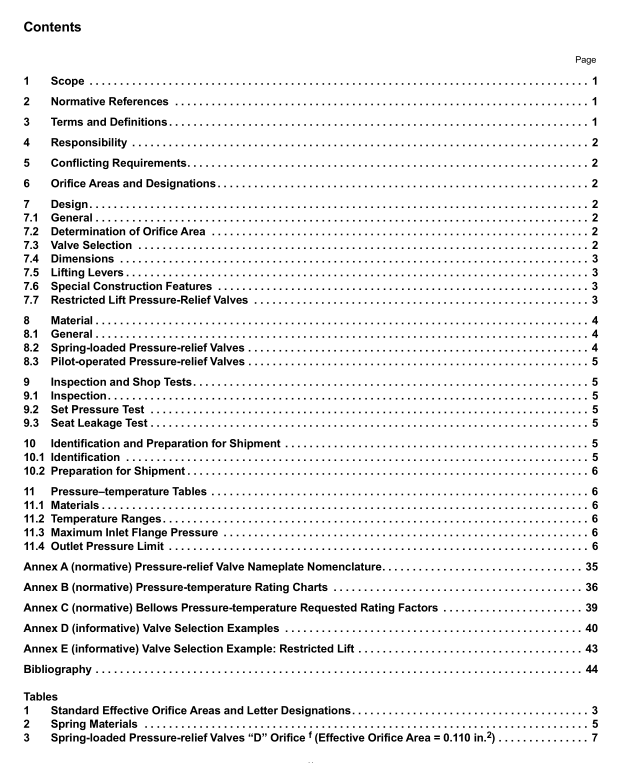API 526 7th pdf download

API 526 7th pdf download Flanged Steel Pressure-relief Valves
7.4Dimensions
Center-to-face dimensions shall be in accordance with Table 3 through Table 16 for spring-loaded valves andTable 16 through Table 29 for pilot-operated valves, with tolerances of±11s in. for valve inlet sizes up to and including4 in., and +1/8 in. for valve inlet sizes larger than 4 in.
Flange facings and dimensions shall be in accordance with ASME B16.5.
For some valve designs, the inlet raised face height may substantially exceed the nominal dimension specitfied inASME B16.5.Consult the manufacturer for exact dimensions.
7.5Lifting Levers
Lifting levers shall be provided when required by ASME BPVC or when designated on the purchaser’s specificationsheet.
As allowed by code for pilot-operated pressure-relief valves, means in lieu of lifting levers may be specified forconnecting and applying adequate pressure to the pilot to verify that the moving parts critical to proper operation arefree to move.
7.6Special Construction Features
Construction features beyond the scope of this standard shall be provided as agreed upon by the manufacturer andthe purchaser and shall be designated on the drawings provided to the purchaser.
7.7Restricted Lift Pressure-Relief Valves
a) Table 1 shows a 21 % to 78 % increase in effective orifice area from one lettered orifice to the next lettered orifice.ln some applications, the user may desire a smaller increase so that the resulting rated capacity is lower.A reduction in the pressure relief valve rated capacity can be achieved by restricting the lift. A restricted lift pressurerelief valve has a reduced flow area (reduced effective orifice area), resulting in a lower rated capacity for thevalve. A lower rated capacity, based on the reduced lift, will lower the inlet and outlet piping pressure losses andreduce the acoustic effects.
b)The rated capacity for restricted lift valves shall be in accordance with ASME BPVC,Section VII.Note that ASME
prohibits restricting the lit to a value less than 30 % of the full rated lift, or less than 0.080 in. The restricted litrelief device shall meet all requirements of this document (e.g. face-to-face dimensions) for the standard valvewith the exception of the restriction in lift.
c) The final relief device design shall meet the requirements in ASME BPVC,Section v1Il. The restriction of the relief
device lift shall only be performed by the valve Manufacturer or Assembler per ASME BPVC, Section vIl.
d) The nameplate on restricted lift relief devices shall be stamped to identify the reduced lift value and the rated
capacity based on that reduced lift value.
e)Restricted lift versions of the pressure-relief valves in Table 3 through Table 30 may be specified by providing the
manufacturer with a required capacity and the maximum desired rated capacity. The manufacturer shall determinethe lift that will provide a rated capacity within these two values.Prior to making a final selection the purchasershall confirm that the restricted lift relief device meets the design requirements (see example in AnnexE).
Material
8.1 General
Materials generally used for construction are covered in this section.For special corrosion problems and applicationsbeyond the pressure-temperature limits of this standard, construction materials shall be those agreed upon by themanufacturer and the purchaser.
8.2Spring-loaded Pressure-relief Valves
The body and bonnet materials shall be in accordance with Table 3 through Table 16 for the required temperaturerange. The body and bonnet may be of different materials but must meet the minimum pressure-temperaturerequirement. The body and bonnet materials shall be equivalent to or better than the follawing types and grades:
-carbon steel, ASME SA-216,Grade wcB;
austenitic stainless steel,ASME SA-351 Grade CF8M;
chromium molybdenum steel ,ASME SA-217,Grade wc6;
—nickel/copper alloy,ASME SA-494 Grade M35-1;
—alloy 20,ASME SA-351 Grade CN7M.
Materials for springs shall be selected per Table 2 on the basis of the operating temperature of the process fuidunless an analysis of the ambient or relieving conditions indicates a spring requiring a different material.
Material for the internal parts of the valve shall be in accordance with the manufacturers standards for thetemperature and service or as indicated on the purchaser’s specification sheet.









